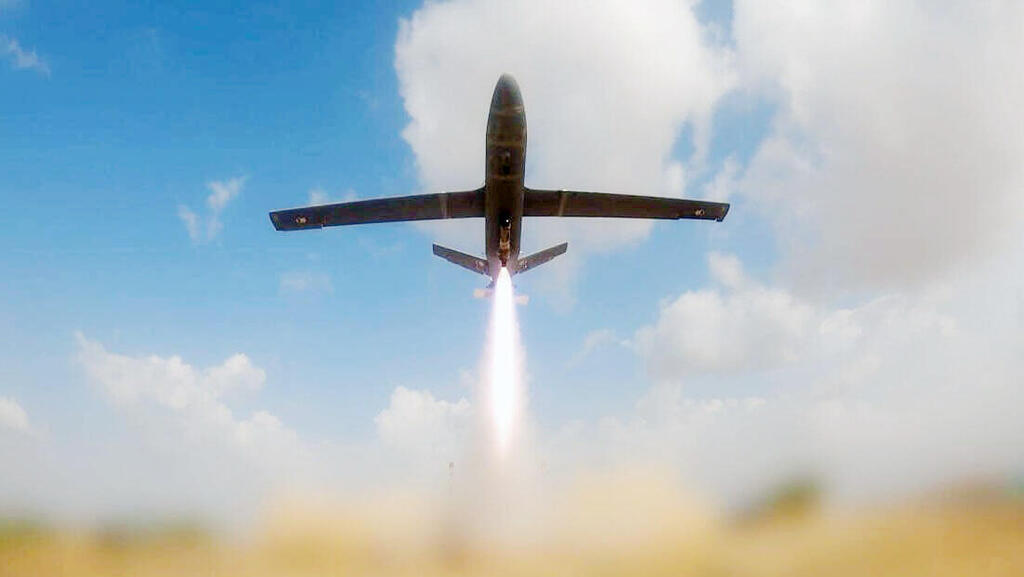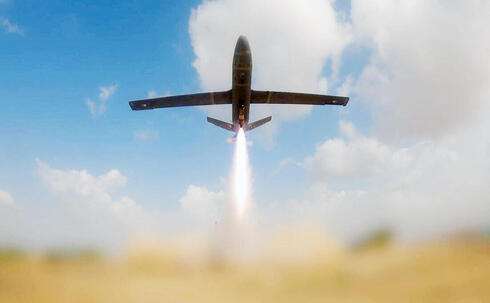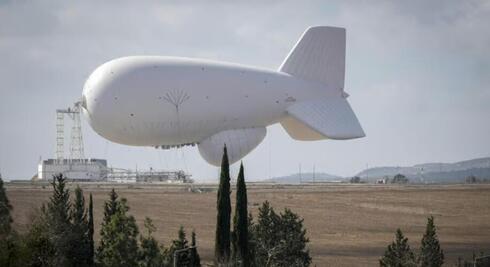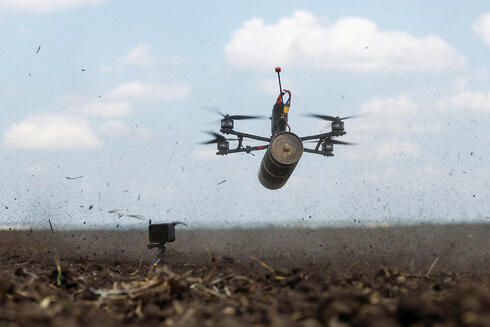
Iron Dome's new nemesis: The rising threat of Hezbollah's UAVs
Hezbollah's UAVs challenge Israel's air defenses daily, posing new threats from Lebanon. Experts caution that an unequivocal technological response is still a work in progress.
The complex reality in the skies of the north, in the shadow of the increasing threat of UAVs that Hezbollah launches daily from Lebanon, was reflected in the incident last Thursday near Shlomi. The fighters of the Sky Rider unit of the artillery corps launched a UAV to scan the area and provide tactical visual intelligence necessary for the forces on alert near the border. The Israeli aircraft, a Skylark UAV from Elbit Systems, was mistakenly detected by the Air Force's air defense system as a hostile UAV launched by Hezbollah. A Tamir missile from an Iron Dome battery turned it into a mass of fragments within seconds.
This was not the first time in the ongoing conflict in the north that an Israeli intercept missile was directed at an Israeli air target mistakenly identified as a "hostile aircraft" from Hezbollah. The IDF has not released data on the full extent of similar incidents since the beginning of the fighting in the northern skies. According to senior officers, such false identifications have already brought down several UAVs of the Sky Rider unit, and in other cases, have also cost the lives of quite a few cranes in the middle of the migration season. "It happens that we shoot at flocks of birds that raise the suspicion of enemy aircraft infiltration due to the combination of altitude, flight speed, and low radar signature," admits a senior officer in a conversation with Calcalist. "And when there is doubt, we launch Iron Dome interceptors," the price of one of which is estimated at $50,000.
Since the start of the skirmish between the IDF and Hezbollah on October 8, more than 1,000 "flying objects" have been launched toward Israel. The number includes suicide drones and drones used to gather intelligence and identify Israeli weak points. About two and a half weeks ago, two Hezbollah UAVs penetrated about 70 kilometers deep into Israeli territory to one of the Air Force's most important and sensitive sites in the Lower Galilee, which serves as a base for the advanced observation system Sky Dew. One was detected and intercepted by a missile, but it served as a diversion, paving the way for an explosive UAV that advanced on a secret flight path, taking advantage of the topographical conditions until it reached the balloon.
The Sky Dew system, based on a huge observation balloon placed near the Golani junction for missile defense, features a high-powered radar from Elta Systems. It is designed to significantly improve the IDF's warning capabilities for cruise missiles and UAVs launched toward Israel from the east and north. However, despite the praise showered on it, Sky Dew did not provide a single warning. The system, previously estimated to cost hundreds of millions of shekels, faced operational difficulties and became a static target under long-term surveillance by Hezbollah. The pictures of the punctured balloon provided Hezbollah with a psychological victory, suggesting Israel's sensitive assets are exposed and vulnerable.
Hezbollah is increasing its attempts to attack UAVs and components of the air defense system in the north to disrupt its activities. This has led the IDF and the security establishment to recognize the need to invest in defending the air defense. Even at the beginning of the fighting, Hezbollah systematically targeted and destroyed cameras and observation systems deployed along the border fence to blind the Israeli military.
Since the beginning of the war, Hezbollah's drones have challenged the IDF "along the entire threat chain," as defined by senior officers. The difficulty is most evident in detection, identification as hostile, and quick interception. Unlike rockets made of metal that fly fast, high, and on a clear course, UAVs made of different components leave a very low radar signature, fly slowly, and sometimes at low altitudes, taking advantage of topographical conditions. When detected and identified, they can be intercepted by Iron Dome, though it was initially designed for short-range rockets. Fighter jets and helicopter gunships also participate in the daily hunt, exposing themselves to significant safety hazards derived from low-altitude combat air activity.
Eight months into the war and with the increased UAV threat in the north, doubts and questions arise about the IDF's equipping and readiness for the threat, given detection, identification, and interception difficulties. Advancing ongoing processes could have eased the IDF's response to Hezbollah's drones. "The writing was on the wall for years, and we still haven't come to this specific threat with proper preparedness," warns a senior officer, criticizing the force-building processes in the IDF and the security establishment in the years leading up to the ongoing UAV war in the north. The defense industries, which developed effective defense systems against rockets, such as Rafael's Iron Dome, already had solutions to reduce the UAV threat years ago. "There were talks, but the bottom line was no significant equipping by the defense establishment with such means," a senior analyst at a major defense company told Calcalist.
"The preparation to deal with this challenge was insufficient, and the changing nature of the aerial threat was not understood in depth," says Dr. Liran Antebi from the Institute for National Security Studies (INSS), who researches UAVs and unmanned vehicles. "Years ago, I discussed the issue with professionals in the Air Force, and the attitude was that in a future conflict with Hezbollah, rockets would be the primary threat, while drones and UAVs would be secondary. This scenario was defined as an extreme case."
A failed policy against drone use by Hamas, which received a weak military response, contributed to their use in the terrorist attack on October 7, when Hamas used them to damage tanks and observation devices. Defense sources claim that the threat was visible to intelligence and the air force, and officials traveled to Ukraine to derive insights on dealing with it. "It is impossible to purchase everything for every threat," a senior security official told Calcalist. "Investment in a defense system against drones would have come at the expense of other equipment budgets."
As revealed by Calcalist in February, the defense establishment's significant change in approach to the UAV threat came only after the war broke out. Measures to improve the protection of essential infrastructures, bases, and sensitive installations against UAVs, costing more than a billion shekels, are still in production processes in the defense industries. "There is an arms race," says Antebi. "When we close one direction, the other side looks for another opening. This is not a case of a terrorist organization buying equipment online."
On the night of Iran's attack on Israel in mid-April, hundreds of long-range ballistic missiles, cruise missiles, and UAVs were launched. The air defense system intercepted most of them successfully. More than two years before this, Brigadier General Ran Kochav, former commander of the air defense system, suggested updating the defense concept to include "regional integration" for improved operational response. "Creating alliances and collaborations at different levels is an important tool," concluded Kochav.
However, security officials and air defense experts lower expectations for an unequivocal technological response to UAV threats, similar to the response to rockets with Iron Dome and David's Sling. The response to UAVs will be established gradually, based on systems and countermeasures, and improvements will be slow and influenced by cumulative experience and technological breakthroughs. Until then, the Israeli public may miss the sense of security provided by Iron Dome.
Part of the solution to the UAV problem will come with Rafael's Iron Beam defense system, designed to intercept air threats with a powerful laser beam, expected to be operational within the next year. "Even when Iron Beam is operational, it will not fully address the UAV threat due to its limited range and weather constraints," says a senior official.
Despite criticism, security sources report successes in intercepting UAVs, mainly through Iron Dome. "There is no modern air defense system that can handle this threat entirely," a source tells Calcalist. "The IDF's handling compared to other armies is reasonable, but the public is accustomed to the high interception rates of Iron Dome. With UAVs, the situation is different."
An IDF spokesperson stated that "the claim that the IDF was not prepared or recognized the threat is false. The IDF is constantly learning and will continue to improve its defenses."
Related articles:
The threat around the corner: agile and deadly explosive drones
In contrast to an attack from Iran, in the arena against Lebanon, UAV flight time to Israel is shorter, and it is doubtful there will be enough friendly air forces to stand by. Dr. Liran Antebi warns of an equally challenging threat of small, agile, accurate, and deadly explosive drones, which debuted in battles between Russia and Ukraine. These FPV drones, originally developed for racing and extreme sports, can perform complex maneuvers at over 200 km/h, accurately penetrate buildings, and carry tiny explosive charges. They are cheap, available, and mass-produced, making them difficult to counter with missiles or jets.
Reports indicate that Ukraine aims to produce about a million of these drones by the end of 2024. "Even if 90% are neutralized, that's still 100,000 potential vulnerabilities," warns Antebi. She emphasizes that the IDF should prepare for these drones, and the security system must seek solutions.
The more distant future poses even more challenges with autonomous versions of these tiny drones using artificial intelligence. Even if the connection to their operators is neutralized, they will continue on their course, presenting a significant threat.



